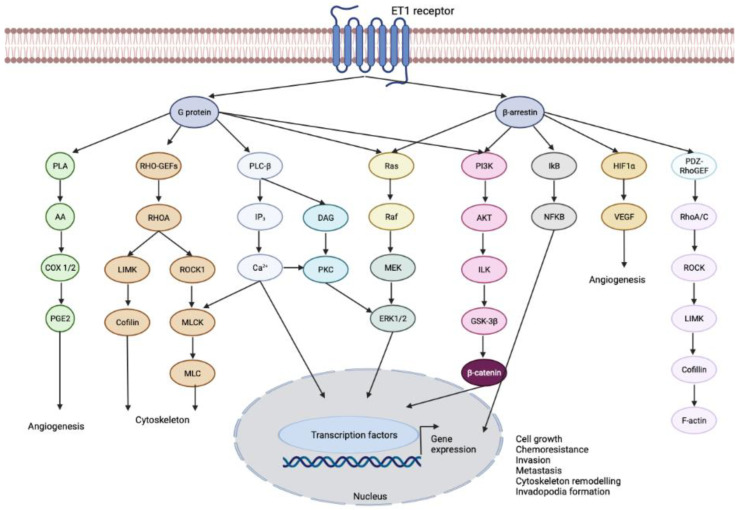Figure 3.
The ET1 signaling network. ET1, a signaling molecule involved in cancer, activates several pathways that contribute to various cellular processes. Upon binding to its receptor, it initiates a cascade of events involving G-protein coupled receptor activation and the activation of primary effectors. One of the pathways activated by ET1 is through the activation of PLCβ. This enzyme cleaves a molecule called phosphatidylinositol-4,5-bisphosphate (PtdIns(4,5)P2) into diacylglycerol (DAG) and inositol triphosphate (IP3). This leads to an increase in calcium levels and the activation of protein kinase C (PKC). Additionally, this pathway triggers the activation of members of the MAPK family, including ERK1/2, which are important for cellular signaling. ET1 activation also stimulates the Ras/Raf/MEK pathway, which converges on the activation of ERK1/2. This pathway plays a role in transmitting signals that regulate cell growth and proliferation. Furthermore, ET1 stimulation activates phospholipase A (PLA), resulting in the release of arachidonic acid (AA) and the activation of cyclooxygenase-1 (COX-1) and COX-2. These enzymes are involved in the production of prostaglandin E2 (PGE2). ET1 also activates PI3K, leading to the activation of AKT, integrin-linked kinase (ILK), and glycogen synthase kinase (GSK)-3β, which in turn stabilizes β-catenin. Importantly, ET1 can also activate ERK1/2 and PI3K/AKT/β-catenin signaling through the involvement of β-arrestin1. Through β-arrestin1, ET1 also activates nuclear factor-kB (NF-kB) signaling by inhibiting NF-kB inhibitor (IkB), leading to the dissociation and subsequent nuclear localization of active NF-kB. Additionally, ET1 activates PDZ-RhoGEF, leading to the activation of Rho-A and -C GTPases. This activation triggers Rho-dependent signaling events through RHO-associated coiled-coil containing protein kinase 1 (ROCK1), resulting in the activation of LIMK and the inhibition of cofilin. Collectively, these signaling pathways, orchestrated by ET-1R, promote cell growth, chemoresistance, angiogenesis, cytoskeleton remodeling, invadopodia formation, and metastasis. By understanding and targeting these pathways, it may be possible to develop therapeutic strategies to intervene in cancer progression.

